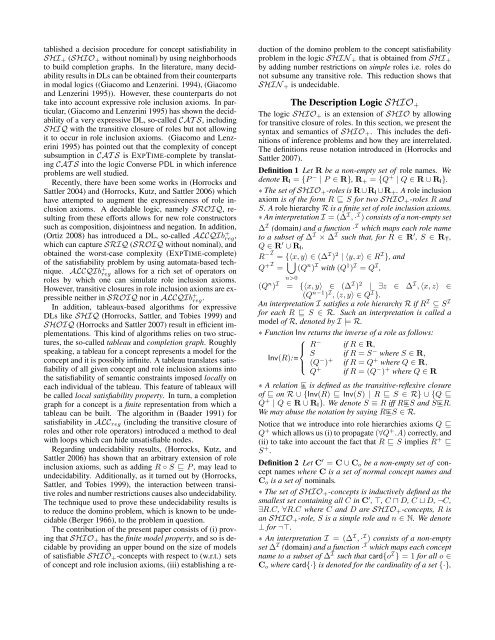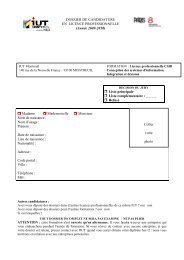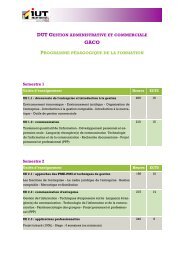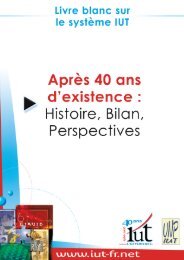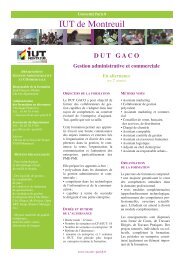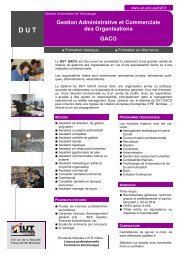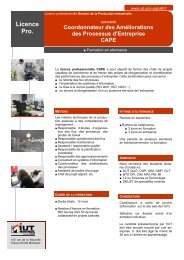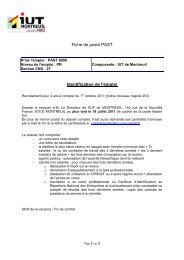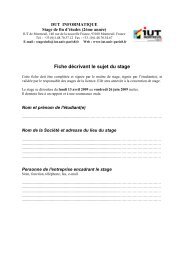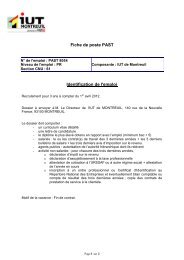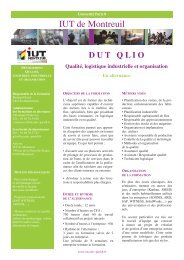Decidability of Description Logics with Transitive Closure of Roles
Decidability of Description Logics with Transitive Closure of Roles
Decidability of Description Logics with Transitive Closure of Roles
You also want an ePaper? Increase the reach of your titles
YUMPU automatically turns print PDFs into web optimized ePapers that Google loves.
tablished a decision procedure for concept satisfiability in<br />
SHI + (SHIO + <strong>with</strong>out nominal) by using neighborhoods<br />
to build completion graphs. In the literature, many decidability<br />
results in DLs can be obtained from their counterparts<br />
in modal logics ((Giacomo and Lenzerini. 1994), (Giacomo<br />
and Lenzerini 1995)). However, these counterparts do not<br />
take into account expressive role inclusion axioms. In particular,<br />
(Giacomo and Lenzerini 1995) has shown the decidability<br />
<strong>of</strong> a very expressive DL, so-called CAT S, including<br />
SHIQ <strong>with</strong> the transitive closure <strong>of</strong> roles but not allowing<br />
it to occur in role inclusion axioms. (Giacomo and Lenzerini<br />
1995) has pointed out that the complexity <strong>of</strong> concept<br />
subsumption in CAT S is EXPTIME-complete by translating<br />
CAT S into the logic Converse PDL in which inference<br />
problems are well studied.<br />
Recently, there have been some works in (Horrocks and<br />
Sattler 2004) and (Horrocks, Kutz, and Sattler 2006) which<br />
have attempted to augment the expressiveness <strong>of</strong> role inclusion<br />
axioms. A decidable logic, namely SROIQ, resulting<br />
from these efforts allows for new role constructors<br />
such as composition, disjointness and negation. In addition,<br />
(Ortiz 2008) has introduced a DL, so-called ALCQIb + reg,<br />
which can capture SRIQ (SROIQ <strong>with</strong>out nominal), and<br />
obtained the worst-case complexity (EXPTIME-complete)<br />
<strong>of</strong> the satisfiability problem by using automata-based technique.<br />
ALCQIb + reg allows for a rich set <strong>of</strong> operators on<br />
roles by which one can simulate role inclusion axioms.<br />
However, transitive closures in role inclusion axioms are expressible<br />
neither in SROIQ nor in ALCQIb + reg.<br />
In addition, tableaux-based algorithms for expressive<br />
DLs like SHIQ (Horrocks, Sattler, and Tobies 1999) and<br />
SHOIQ (Horrocks and Sattler 2007) result in efficient implementations.<br />
This kind <strong>of</strong> algorithms relies on two structures,<br />
the so-called tableau and completion graph. Roughly<br />
speaking, a tableau for a concept represents a model for the<br />
concept and it is possibly infinite. A tableau translates satisfiability<br />
<strong>of</strong> all given concept and role inclusion axioms into<br />
the satisfiability <strong>of</strong> semantic constraints imposed locally on<br />
each individual <strong>of</strong> the tableau. This feature <strong>of</strong> tableaux will<br />
be called local satisfiability property. In turn, a completion<br />
graph for a concept is a finite representation from which a<br />
tableau can be built. The algorithm in (Baader 1991) for<br />
satisfiability in ALC reg (including the transitive closure <strong>of</strong><br />
roles and other role operators) introduced a method to deal<br />
<strong>with</strong> loops which can hide unsatisfiable nodes.<br />
Regarding undecidability results, (Horrocks, Kutz, and<br />
Sattler 2006) has shown that an arbitrary extension <strong>of</strong> role<br />
inclusion axioms, such as adding R ◦ S ⊑ P , may lead to<br />
undecidability. Additionally, as it turned out by (Horrocks,<br />
Sattler, and Tobies 1999), the interaction between transitive<br />
roles and number restrictions causes also undecidability.<br />
The technique used to prove these undecidability results is<br />
to reduce the domino problem, which is known to be undecidable<br />
(Berger 1966), to the problem in question.<br />
The contribution <strong>of</strong> the present paper consists <strong>of</strong> (i) proving<br />
that SHIO + has the finite model property, and so is decidable<br />
by providing an upper bound on the size <strong>of</strong> models<br />
<strong>of</strong> satisfiable SHIO + -concepts <strong>with</strong> respect to (w.r.t.) sets<br />
<strong>of</strong> concept and role inclusion axioms, (iii) establishing a reduction<br />
<strong>of</strong> the domino problem to the concept satisfiability<br />
problem in the logic SHIN + that is obtained from SHI +<br />
by adding number restrictions on simple roles i.e. roles do<br />
not subsume any transitive role. This reduction shows that<br />
SHIN + is undecidable.<br />
The <strong>Description</strong> Logic SHIO +<br />
The logic SHIO + is an extension <strong>of</strong> SHIO by allowing<br />
for transitive closure <strong>of</strong> roles. In this section, we present the<br />
syntax and semantics <strong>of</strong> SHIO + . This includes the definitions<br />
<strong>of</strong> inference problems and how they are interrelated.<br />
The definitions reuse notation introduced in (Horrocks and<br />
Sattler 2007).<br />
Definition 1 Let R be a non-empty set <strong>of</strong> role names. We<br />
denote R I = {P − | P ∈ R}, R + = {Q + | Q ∈ R ∪ R I }.<br />
∗ The set <strong>of</strong> SHIO + -roles is R∪R I ∪R + . A role inclusion<br />
axiom is <strong>of</strong> the form R ⊑ S for two SHIO + -roles R and<br />
S. A role hierarchy R is a finite set <strong>of</strong> role inclusion axioms.<br />
∗ An interpretation I = (∆ I , ·I) consists <strong>of</strong> a non-empty set<br />
∆ I (domain) and a function ·I which maps each role name<br />
to a subset <strong>of</strong> ∆ I × ∆ I such that, for R ∈ R ′ , S ∈ R T ,<br />
Q ∈ R ′ ∪ R I ,<br />
R −I = {〈x, y〉 ∈ (∆ I ) 2 | 〈y, x〉 ∈ R I }, and<br />
Q +I = ⋃ n>0(Q n ) I <strong>with</strong> (Q 1 ) I = Q I ,<br />
(Q n ) I = {〈x, y〉 ∈ (∆ I ) 2 | ∃z ∈ ∆ I , 〈x, z〉 ∈<br />
(Q n−1 ) I , 〈z, y〉 ∈ Q I }.<br />
An interpretation I satisfies a role hierarchy R if R I ⊆ S I<br />
for each R ⊑ S ∈ R. Such an interpretation is called a<br />
model <strong>of</strong> R, denoted by I |= R.<br />
∗ Function Inv returns the inverse <strong>of</strong> a role as follows:<br />
⎧<br />
⎪⎨<br />
Inv(R):=<br />
⎪⎩<br />
R − if R ∈ R,<br />
S if R = S − where S ∈ R,<br />
(Q − ) + if R = Q + where Q ∈ R,<br />
Q + if R = (Q − ) + where Q ∈ R<br />
∗ A relation ∗⊑ is defined as the transitive-reflexive closure<br />
<strong>of</strong> ⊑ on R ∪ {Inv(R) ⊑ Inv(S) | R ⊑ S ∈ R} ∪ {Q ⊑<br />
Q + | Q ∈ R ∪ R I }. We denote S ≡ R iff R ∗⊑S and S ∗⊑R.<br />
We may abuse the notation by saying R ∗⊑S ∈ R.<br />
Notice that we introduce into role hierarchies axioms Q ⊑<br />
Q + which allows us (i) to propagate (∀Q + .A) correctly, and<br />
(ii) to take into account the fact that R ⊑ S implies R + ⊑<br />
S + .<br />
Definition 2 Let C ′ = C ∪ C o be a non-empty set <strong>of</strong> concept<br />
names where C is a set <strong>of</strong> normal concept names and<br />
C o is a set <strong>of</strong> nominals.<br />
∗ The set <strong>of</strong> SHIO + -concepts is inductively defined as the<br />
smallest set containing all C in C ′ , ⊤, C ⊓ D, C ⊔ D, ¬C,<br />
∃R.C, ∀R.C where C and D are SHIO + -concepts, R is<br />
an SHIO + -role, S is a simple role and n ∈ N. We denote<br />
⊥ for ¬⊤.<br />
∗ An interpretation I = (∆ I , ·I) consists <strong>of</strong> a non-empty<br />
set ∆ I (domain) and a function ·I which maps each concept<br />
name to a subset <strong>of</strong> ∆ I such that card{o I } = 1 for all o ∈<br />
C o where card{·} is denoted for the cardinality <strong>of</strong> a set {·},


